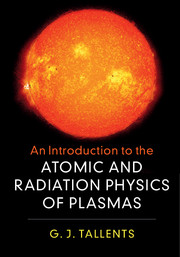Book contents
- Frontmatter
- Contents
- Preface
- 1 Plasma and Atomic Physics
- 2 The Propagation of Light
- 3 Scattering
- 4 Radiation Emission in Plasmas
- 5 Radiation Emission Involving Free Electrons
- 6 Opacity
- 7 Discrete Bound Quantum States: Hydrogen and Hydrogen-Like Ions
- 8 Discrete Bound States: Many-Electron Atoms and Ions
- 9 Discrete Bound States: Molecules
- 10 Radiative Transitions between Discrete Quantum States
- 11 Collisions
- 12 Collisional-Radiative Models
- 13 High-Density Plasmas
- Appendix Vectors, Maxwell's Equations, the Harmonic Oscillator and a Sum Rule
- References
- Index
11 - Collisions
Published online by Cambridge University Press: 21 February 2018
- Frontmatter
- Contents
- Preface
- 1 Plasma and Atomic Physics
- 2 The Propagation of Light
- 3 Scattering
- 4 Radiation Emission in Plasmas
- 5 Radiation Emission Involving Free Electrons
- 6 Opacity
- 7 Discrete Bound Quantum States: Hydrogen and Hydrogen-Like Ions
- 8 Discrete Bound States: Many-Electron Atoms and Ions
- 9 Discrete Bound States: Molecules
- 10 Radiative Transitions between Discrete Quantum States
- 11 Collisions
- 12 Collisional-Radiative Models
- 13 High-Density Plasmas
- Appendix Vectors, Maxwell's Equations, the Harmonic Oscillator and a Sum Rule
- References
- Index
Summary
To calculate quantum state densities when a plasma is not in thermodynamic equilibrium, it is necessary to examine the individual processes populating and de-populating the quantum states. We have already considered the radiative processes (spontaneous radiative decay, photo-excitation and stimulated emission in Section 4.2 and free-bound radiative recombination in Section 5.4). Typical radiative reactions involved are listed in Table 11.1.
Other processes which need to be taken into account to evaluate quantum state population densities are collision induced. In colliding with an ion, electrons (and to a lesser extent other ions) can cause transitions between quantum states and between discrete quantum states and free electrons. A list of collisional reactions affecting quantum state populations is given in Table 11.2. Models calculating plasma quantum state densities and consequent radiation emission and absorption properties using rates of radiative and collisional processes are known as collisional radiative models [89].
Collisions in Plasmas
When the electrons, ions and atoms in a plasma undergo collisions they share energy and momentum so that a thermal distribution (Equation 1.22) characterised by a temperature and number density is produced. We considered the idea of a collision of an electron with an ion in Section 5.2 where the acceleration of the electron produces bremsstrahlung emission. Only a small loss of energy to radiation occurs with each collision.
In collisions between similar mass particles such as electron–electron and ion– ion collisions, the charged particle momentum and energy can be readily exchanged between the colliding particles. Collision between electrons and ions also transfer energy, but at a rate which is slower by the relative mass of the ions and electrons. Where the kinetic energy of colliding particles is conserved (apart from the small bremsstrahlung emission), the collision is referred to as being elastic.
Inelastic collisions involve changes in the bound quantum state of an ion or atom as a result of the collision. Energy is transferred from an electron kinetic energy to the potential energy of a bound electron (or vice versa).
An important measure with all collisions is the value of the cross-section for the collision.
Information
- Type
- Chapter
- Information
- An Introduction to the Atomic and Radiation Physics of Plasmas , pp. 208 - 225Publisher: Cambridge University PressPrint publication year: 2018
